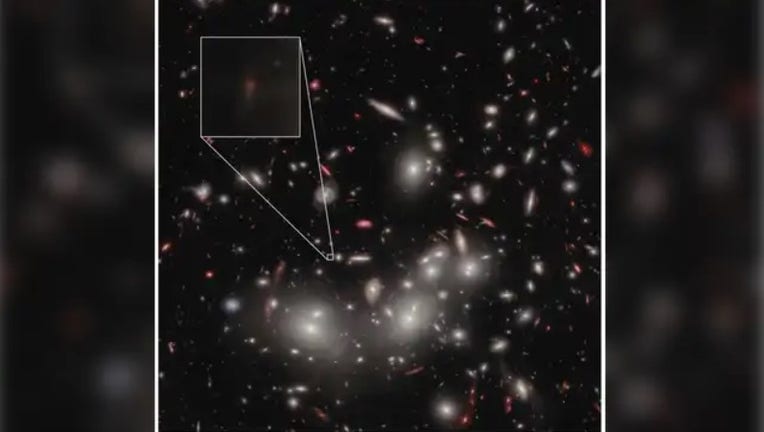Faintest galaxy yet from early universe spotted by James Webb Space Telescope

Galaxy JD1 (Image: Guido Roberts-Borsani/UCLA); original images: NASA, ESA, CSA, Swinburne University of Technology, University of Pittsburgh, STScI) (NASA)
The powerful James Webb Space Telescope continues to revolutionize what astronomers know about the universe as far back as soon after the Big Bang and the cosmic dark ages.
A research team led by University of California Los Angeles astrophysicists recently published their findings in the journal Nature, confirming the existence of the faintest galaxy ever seen from the early universe known as JD1.
HOW JWST IS DELVING DEEPER INTO OUR UNIVERSE THAN EVER BEFORE
Hundreds of millions of years before bright galaxies dominated the universe, things were much darker in a period after the Big Bang known as the cosmic dark ages. According to the research team, JD1 is among the first galaxies to burn away the hydrogen fog leftover from the Big Bang during a period known as the Epoch of Reionization, shining through and creating the universe as we know it today.
Astronomers want to study the first generation of galaxies to understand how the cosmic dark ages ended.
The research team used JWST's powerful near-infrared camera, NIRCam, to photograph JD1 as it was 13.3 billion years ago and the near-infrared spectrograph instrument to determine JD1's age and distance from Earth.
Before Webb's sensitivity, researchers said, it was not possible to confirm a galaxy as dim as JD1.
According to the study, JD1 is tiny at only a fraction of the size of the Milky Way, our home galaxy. The young galaxy is also incredibly hard to see without the help of a nearby cluster of galaxies known as Abel 2744. The galaxies help bend and magnify the light from JD1 in a process known as gravitational lensing, making it appear brighter.
"Before the Webb telescope switched on, just a year ago, we could not even dream of confirming such a faint galaxy," UCLA physics and astronomy professor and study co-author Tommaso Treu said in a news release. "The combination of JWST and the magnifying power of gravitational lensing is a revolution. We are rewriting the book on how galaxies formed and evolved in the immediate aftermath of the Big Bang."
Study co-author and UCLA researcher Guido Roberts-Borsani said Webb more commonly finds rare bright galaxies, but those don't likely offer a full picture of the galaxies from the early universe.
JWST is a partner program with NASA, the Canadian Space Agency and the European Space Agency. After launching on Christmas in 2021, the telescope began operating in space in the summer of 2022.
Read more of this story from FOX Weather.

